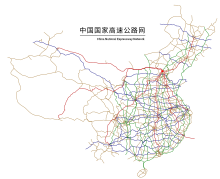This article may require cleanup to meet Wikipedia's quality standards. The specific problem is: Citations are lackluster in both English version and Chinese version articles relating to Chinese expressways. (April 2018) |
| National Trunk Highway System 中国国家干线公路系统 Zhōngguó Guójiā Gànxiàn Gōnglù Xìtǒng | |
|---|---|

 The sign of regional expressway S1 for Gansu Province and the sign of national expressway G3 Beijing-Taipei Expressway below | |
 A map of the national expressways of China | |
| System information | |
| Maintained by Ministry of Transport of the People's Republic of China | |
| Length | 177,000 km (2022) (110,000 mi) |
| Formed | 7 June 1984 |
| Highway names | |
| Expressways: | GXX (National expressways) GXXxx (Auxiliary National expressways) SXX (Regional expressways) |
| System links | |
| Expressways of China | |||||||
|---|---|---|---|---|---|---|---|
| Simplified Chinese | 中国国家干线公路系统 | ||||||
| Traditional Chinese | 中國國家幹線公路系統 | ||||||
| Hanyu Pinyin | Zhōngguó Guójiā Gànxiàn Gōnglù Xìtǒng | ||||||
| Literal meaning | China National Highway System | ||||||
| |||||||
The expressway network of China, with the national-level expressway system officially known as the National Trunk Highway System (Chinese: 中国国家干线公路系统; pinyin: Zhōngguó Guójiā Gànxiàn Gōnglù Xìtǒng; abbreviated as NTHS), is an integrated system of national and provincial-level expressways in China.[1][2]
With the construction of the Shenyang–Dalian Expressway beginning between the cities of Shenyang and Dalian on 7 June 1984, the Chinese government started to take an interest in a national expressway system. The first modern at-grade China National Highways is the Shanghai–Jiading Expressway, opened in October 1988.[note 1] The early 1990s saw the start of the country's massive plan to upgrade its network of roads.[1][dead link][3] On 13 January 2005, Zhang Chunxian, China's Minister of Transport introduced the 7918 network, later renamed the 71118 network, composed of a grid of 7 radial expressways from Beijing, 9 north–south expressways (increased to 11), and 18 east–west expressways that would form the backbone of the national expressway system.[2][dead link][4]
By the end of 2020, the total length of China's expressway network reached 161,000 kilometres (100,000 mi),[5] the world's largest expressway system by length, having surpassed the overall length of the American Interstate Highway System in 2011.[6] Many of the major expressways parallel routes of the older China National Highways.[citation needed] By the end of 2022, the total length of China's expressway network reached 177,000 kilometres (110,000 mi).[7]
- ^ a b Li, Si-ming and Shum, Yi-man. Impacts of the National Trunk Highway System on accessibility in China Archived 22 June 2010 at the Wayback Machine. Journal of Transport Geography.
- ^ a b 国家高速公路网规划 (National Trunk Highway System Planning) Archived 2014-01-14 at the Wayback Machine. 13 January 2005. (in Chinese)
- ^ 国内首条取消收费高速公路改建工程启动 Archived 2016-01-08 at the Wayback Machine. News.cn. (in Chinese)
- ^ Cite error: The named reference
:0was invoked but never defined (see the help page). - ^ "多项指标位居世界第一 我国从"交通大国"迈向"交通强国"". 新华网. 31 May 2021. Archived from the original on 24 June 2021. Retrieved 16 June 2021.
- ^ "我国高速公路通车里程位居世界第一 骨架网络正加快贯通". 第一财经日报. Archived from the original on 3 May 2019. Retrieved 17 July 2017.
- ^ "数说中国 我国高速公路通车里程稳居世界第一". 新华网.
Cite error: There are <ref group=note> tags on this page, but the references will not show without a {{reflist|group=note}} template (see the help page).